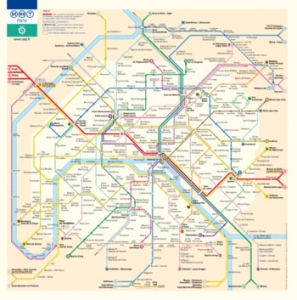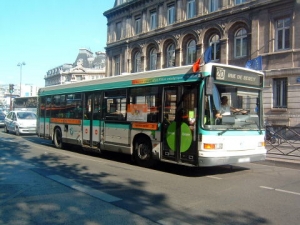Cool- Paris is a website in which covers information on Hotels, tour,food,shopping,sightseeing,and more. You are experiencing Paris without even visiting!
 Welcome,Guest User
Welcome,Guest User
Home > Getting Around
Cool- Paris is a website in which covers information on Hotels, tour,food,shopping,sightseeing,and more. You are experiencing Paris without even visiting!
Home > Getting Around
The best and cheapest way to get around Paris is on foot, and secondly, using the Métro which costs €1.70 for a one way trip of any length.

Paris has an excellent underground train system, known as the Métro.There are 16 Métro lines (lignes) (1-14, 3bis, and 7bis) on which trains travel all day at intervals of a few minutes 05:00-00:30 (Saturday night/Sunday morning: 01:30), stopping at all stations on the line. Times for trains can be seen on an electronic scrollboard above the platform. Line 14, which is fully automated, is called the Méteor. Scheduled times for first and last trains are posted in each station on the centre sign. Generally, except for early and late hours, travellers should not worry about specific Metro train times; just get to your station and take the next train. Trains usually come 2-3 minutes apart during rush hour and 5-10 minutes apart during other times, depending on the line.
For the subway, a single ticket (ticket t+) costs €1.70; however, it is generally not advisable to buy tickets by the unit. Instead, purchase a "carnet" of ten tickets, which can be bought for €13.70 at any station, which will bring the price per ticket down to €1.37. Tickets named tarif réduit may be purchased for children under the age of 10 but only in a carnet of 10 for €6.65. Both tickets are valid for unlimited metro and RER or bus and tram transfers during two hours for RER and metro, and 1 hour 30 between the first and the last punch for bus and tram. RER + Métro and Bus + Tram are two separate systems, but they use the same tickets. This means you have to use a new ticket if you transfer from bus to metro or from metro to bus. Tickets do not expire.

The Paris RER is 5 express train lines connecting Paris city centre to surrounding suburbs. Within Paris the RER acts as an express underground or subway train. Beyond the centre, the Paris RER is a ground level commuter train connecting outlying suburbs and popular destinations such as CDG Airport and Euro Disney to the heart of Paris.
Paris RER trains use two different types of tickets depending on which part of the RER network you will be traveling. When taking an RER train strictly within central Paris Zone 1 (visible in the first RER Map), you can use a basic Paris Metro ticket for travel on the RER. Travel beyond Paris Zone 1 on the RER requires a special ticket: a Billet Ile-de-France.

Since the Métro is primarily structured around a hub-and-spoke model, there are some journeys for which it can be quite inefficient, and in these cases, it is worth seeing if a direct bus route exists, despite the complexity of the bus network. A bus ride is also interesting if you want to see more of the city. The Parisian bus system is quite tourist-friendly. It uses the same single-ride Ticket t+ and Navigo fare system as the Métro, and electronic displays inside each bus tell riders its current position and what stops remain, eliminating a lot of confusion.
These same payment devices are also valid in the Noctilien, the night bus. Noctilien route numbers are prefaced with an N on the bus stop signage. Night buses run regularly through the central hub at Chatelet and from the mainline train stations to outlying areas of greater Paris. There is also a circle line connecting the main train stations. It pays to know your Noctilien route ahead of time in case you miss the last Métro home. Women travellers should probably avoid taking the Noctilien on their own to destinations outside Paris.

Renting a bike is a very good alternative over driving or using public transport and an excellent way to see the sights. Riding a bike anywhere in the city is far safer for the moderately experienced cyclists than most towns or cities in other countries. The French are very cognisant of cyclists, almost to a point of reverence. A few years ago Paris wasn't the easiest place to get around by bike but that has changed dramatically in recent years. The city government has taken a number of steps in strong support of improving the safety and efficiency of the urban cyclist as well as establishing some separated bike lanes but, even more importantly, instituted a policy of allowing cyclists to share the ample bus lanes on most major boulevards. Paris also has many riversides which are perfect for cycling. The Paris bike network now counts over 150km of either unique or shared lanes for the cyclist. In addition, the narrower, medieval side streets of the central arrondissements make for rather scenic and leisurely cycling, especially during off-peak hours of the day when traffic is lighter. Do remember to bring a good map, since there is no grid plan to speak of and almost all of the smaller streets are one-way.